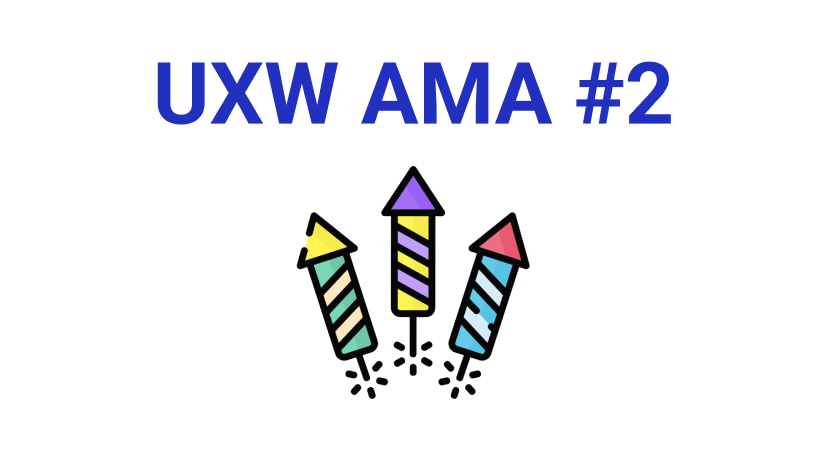Table of Contents
I love giving back.
The world is better when we pay knowledge forward. As I’ve progressed in my UX writing journey, I’ve felt a deep responsibility to share what I’ve learned since I entered the field in 2018.
Often, l post thoughts on LinkedIn.
In fall 2021, I completed a 13-part Ask Me Anything series there. I’ve collected questions and answers from the project about managing tools, relationships, and time. In a previous post, I shared questions and answers about breaking into UX writing and content design.
Stay curious, and give back when you can. We can all do something to make the world a little smaller.
Part 1: Working with tools as UX writers
Question: I’m wondering what top three tools you think new content designers should focus on mastering. I’d also love to know what functionalities you think are the most important within each of them.
Andrew: If you were to ask this question to a group of content designers, you would receive so many different, interesting answers.
Here’s my take:
1.) Figma
As a writer, I’ve worked with InVision, Figma, and now Framer to edit copy within designs. Figma seems to be widely used, and it’s fairly intuitive. I’ve only touched the words within wireframes. But it wouldn’t hurt to get a basic understanding of how UX designers use the tool in their work.
2.) Grammarly & Hemingway Editor (I can’t separate them!)
I use both daily. Grammarly is great for grammar checks and inspecting a sentence’s clarity. Hemingway Editor is more limited, but it catches unnecessary adverbs, complex words, and passive voice examples. I’ve cleaned up so much copy with both tools. I also have Grammarly for Chrome, which is a nice check-as-you-go option when working outside the Grammarly app.
Go to the complete answer
Part 2: When UX writers work on copy
Question: Do UX writers just work on copy before the launch of a product or do they work even after the product has been launched?
Andrew: In a perfect world, both!
Most of my work has been on designs that iterate on an existing product. Things constantly evolve. There’s never a shortage of tasks for sure.
After something is shipped, you learn what works well and what doesn’t. Then you solve problems.
Other writers may have different experiences, but it’s rare a major product goes untouched after it is presented to the world.
Pace of life depends on the company and the structure of a UX team. But it’s not uncommon to see a minimum viable product released, and then design work continues on the next version. Then more design work follows that version. And so on.
Part 3: UX writing hacks
Question: If you’ve discovered any hack or idea on your UX writing journey, do you mind sharing it with me?
Andrew: Oh, this is a fun question! I’ll approach it in a few ways.
From a growth perspective, follow industry hashtags on LinkedIn and connect with people who use them often. Then become an active contributor.
Journaling about my professional life has opened multiple doors.
I’ve received invites to participate in webinars and podcast appearances and contribute to blog posts. My pair writing project with the awesome Katrin Suetterlin began after we connected here.
With the job itself, I’ve learned patience and an ability to compromise are two of the most valuable traits you can show.
So many people have opinions about the words in a design. The content within a flow can be low-hanging fruit for many of our cross-functional colleagues.
As a UX writer, it’s important to be respectful, take feedback well, and know when to act on suggested changes.
Go to the complete answer
Part 4: Storytelling in UX writing
Question: Do you believe storytelling is a vital component of UX writing? If storytelling is vital, why do you think other writing disciplines (besides UX writing) minimize its importance?
Andrew: Yes, storytelling is a vital component of UX writing. In fact, when discussing topics related to this field, I’m not sure we place enough emphasis on it.
After all, we want anyone who uses our products to be the hero of their journey. We want to guide someone through the beginning, middle, and end of what they’re trying to accomplish within our experiences.
Storytelling takes many forms. In my old life, I wrote stories that were more than 2,000 words. Those included storytelling elements.
My current job is different. But I keep a narrative arc in mind when helping with designs for a flow.
“Does going from Point A to Point B here make sense?”
“Are the transitions between screens what someone would expect?”
“Is there a satisfying conclusion after all the time someone invested in an action?”
Regarding your second question, I can only share what I’ve seen in the digital media world. It comes down to financial considerations and modern reading habits.
Media organizations study what’s read. They optimize content and shape strategies that react to how their work is consumed.
These days, many people prefer bite-sized content that tends to include a strong opinion, regardless of whether they agree with the opinion shared.
Part 5: Reaching out to companies to get UX writing experience
Question: How do you advise reaching out to a company or organization to do some UX writing for experience but not pay?
Andrew: I appreciate this question. It’s a tough situation, right? We need something to show prospective employers, but it can be hard to find places that will offer breakthrough opportunities.
I’ll preface my answer by saying I don’t have direct experience with this situation in the UX world. Likely, other people have better advice. But in my journalism life, I sought freelance assignments that resulted in payment.
No matter our experience, our work has value. This is only my opinion, but if I were you, I’d try to receive something for your time and effort.
When reaching out, try to be strategic. You can start with your immediate network and see if anyone has needs. If that doesn’t work, try to connect with UX or marketing professionals at companies that interest you.
Go to the complete answer
Further Reading
UX Writing AMA (Ask Me Anything) Part 1: Breaking into the Field
What Is UX Writing? A Complete Guide For Beginners



